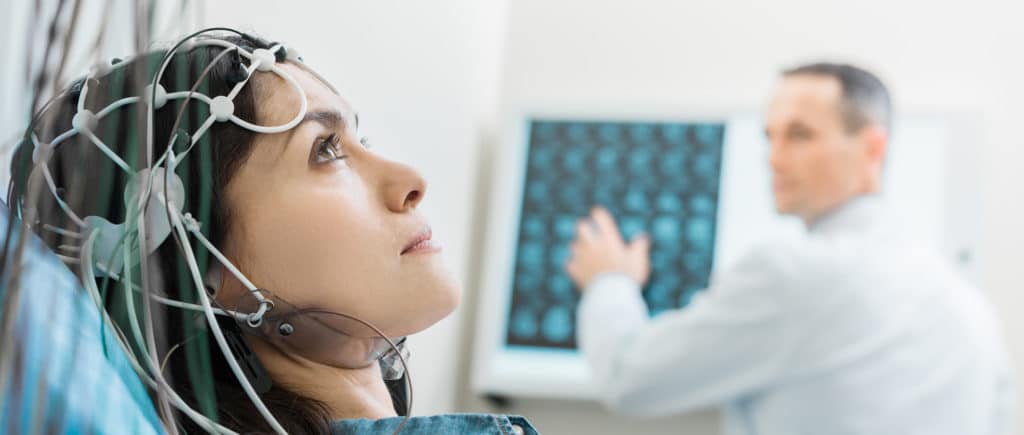

Table of Contents
What are Neuro Training and Neurofeedback?
Neuro training and neurofeedback are the processes of using brain imaging devices to provide live brain activity, neuroimaging, and functioning. This type of neuroimaging allows professionals to train the brain to function differently. With the use of brain mapping and brain stimulation, those who undergo brain training will be connected to electronics and computer software that will detect, amplify, and even record brain activity.
As the professionals are getting live feedback from the brain, they can decide whether the brain is experiencing normal functioning and if it is within normal limits. These brain patterns can guide changes that can produce positive results in physical, emotional, and cognitive brain states.
Because of neuroplasticity and the idea that the brain can change and adapt to experiences, researchers believe that you can train your brain to improve your mental state and improve your quality of life. Through the process of neurogenesis, researchers will train your brain using different brain wave frequencies (alpha, beta, etc.) to support positive neurofeedback.1
Why Train Your Brain
Brain training and neurofeedback have been shown to work wonders in numerous areas of the brain. Not only can brain training and brain mapping assist in the treatment of psychological disorders, but they can also potentially have other benefits.
Some of these benefits of training your brain include:
- Improved memory
- Treatment for headache and migraines
- Improved attention
- Treatment of mental illness
- Treatment of Parkinson disease
- Treatment of OCD
- Assistance and pain management
- Improved anxiety and depression
- Improved sleep
While much of this brain waves research is still underway, scientists are finding new and improved ways to use brain mapping and neuroimaging to improve the lives of many people.2
Who Does Neuro Training Benefit?
Researchers have found that some groups may benefit from brain training. For example, individuals who experience psychological disorders, have learning disabilities, and even have executive functioning disabilities may experience benefits of neuro training.
Psychological Disorders
Numerous psychological disorders, including substance use, OCD, insomnia, depression, anxiety, and more may experience improvements in their disorders by participating in brain mapping exercises. Furthermore, neurofeedback can help individuals improve sleep patterns and even treat addictive disorders by reducing temptations and cravings.2
Executive Function Disorders
Neurofeedback and brain training can also help manage the symptoms of attention deficit hyperactivity disorder (ADHD). Because ADHD may relate to abnormalities in the right frontal lobe, neurofeedback can be used to normalize behavior without the use of medications. Additionally, neurofeedback training has shown to have long-term improvements in ADHD symptoms.2
Learning Disabilities
Even though learning disabilities are more common for school-age children, those who have learning disabilities, such as dyslexia and dyscalculia, may benefit from brain training and neurotherapy. (3) Because many individuals with their disabilities may have a hard time understanding math problems or trouble reading, they can be trained using alpha wave activity via neurofeedback to improve mental functioning.4
Memory Disorders
Auditory and Visual Processing Disorders
How to Prepare for Neuro Training
Luckily, there is not much that you will need to do to prepare for neuro training. Most often, the professionals involved will set up the session and you simply need to attend your neuro training session and be prepared to be monitored consistently as your brain undergoes neurogenesis.
What to Expect
Neuro training and the process of neurogenesis via neurofeedback require some equipment like computer software and hardware. For example, you can expect the following equipment to be present when you go to your brain training session:
- Electrodes and sensors
- Caps with multiple electrodes
- Amplifier
- Computer software
With the use of this equipment, professionals will monitor your brain activity and watch for neurogenesis. Additionally, you will need to attend multiple sessions to experience changes in the brain. Fortunately, your brain can adapt and change so that, once the electrical patterns have been repeated several times, they will become a habit for your brain and you will quickly pick up new patterns.
Do’s and Don’ts of Neuro Training
To prepare for your neuro training session, there are some do’s and don’ts that you should adhere to. The best way to understand what you should do and what you should avoid before your neuro training session is to talk to the professional for recommendations. However, we have listed a couple of do’s and don’ts in the section below.
Do:
- Go to the gym: Exercise is a great way to help your body and mind release stress or anxiety. If you work out before your neurofeedback appointment, you can arrive at your session feeling less stressed.
- Rest: Make sure you receive an adequate amount of sleep before your neuro training session so that you will be ready to participate in a successful session.
Don’t:
- Eat caffeine, alcohol, sugar, or processed foods: Because some of these substances can harm your brain, you should avoid them at least one to two days before your appointment.
- Take out your contacts: If you remove your contacts, you may blink more than normal, and your eye movement may not be typical of your normal functioning. This eye movement can impair your results.
- Go with wet or dirty hair: You should have clean hair the day of your appointment as you may have a cap or sensors attached to your head. Avoid using hair gels, going with wet hair, or adding significant amounts of hair product before your appointment.
How Many Sessions Would be Required?
Choosing the Right Specialists for Neuro Training
The International Society for Neurofeedback and Research is the largest group of professionals who are licensed to not only practice neurofeedback and its research but can also teach the process and develop new studies. For that reason, checking out the list of professionals who are part of the society is the first step to finding the right specialist for brain function assessment and deep brain mapping.
To find the right specialist for neuro training, it’s important to look for someone who is licensed to practice, has a reputation for success, and find someone who will work with you to provide the most quality care. Furthermore, you want to work with someone who has your best interest in mind and can alter interventions and training processes as needed.
If you would like to learn more about neuro training, reach out to J. Flowers Health Institute today.
Resources
- https://isnr.org/neurofeedback-introduction
- https://www.ncbi.nlm.nih.gov/pmc/articles/PMC4892319/#B91
- https://pubmed.ncbi.nlm.nih.gov/19711183/
- https://pubmed.ncbi.nlm.nih.gov/23314778/
- https://pubmed.ncbi.nlm.nih.gov/22254807/
- https://pubmed.ncbi.nlm.nih.gov/22323675/
- https://pubmed.ncbi.nlm.nih.gov/22715481/
- https://www.neurofeedbackslc.com/faq.html





